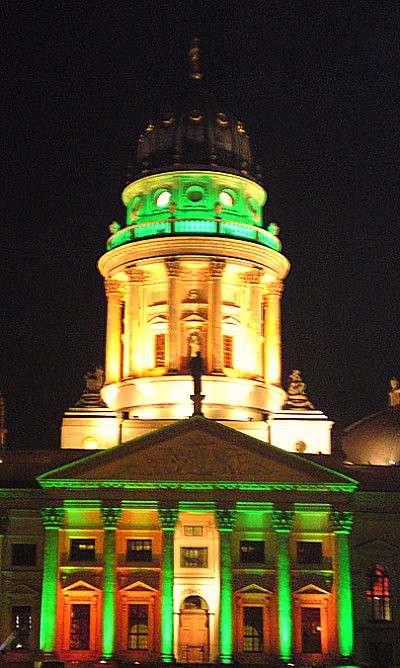
Berlin’s Deutscher Dom – not to be confused with the Berliner Dom which is the largest protestant church in Berlin – is best known as one of the three buildings which make up the spectacular ‘trinity ensemble’ in the Gendarmenmarkt square in Mitte including its twin the Französische Dom (French Cathedral) and the Konzerthaus or Concert Hall. The Deutscher Dom was erected in 1708 under Elector Friedrich III, who had crowned himself King Friedrich I in 1701 and was intent, along with his wife Queen Sophie Charlotte, in turning Berlin into a royal residence to rival Versailles.
The building is by Martin Grünberg and was given its galleried ‘dome’ (hence the name Dom) originating from the French ‘dome’ or cupola, in 1785 by Carl von Gontard. It was known as the Neue Kirche (New Church) and only later referred to as the German Church. It is considered remarkable because of its five-sided floor plan. In 1780 Friedrich’s grandson, Friedrich the Great (1740-1786) commissioned Carl von Gontard to build two non-functional domes for the existing churches to offset the Comedy Theatre next to them ensembles which were inspired by Christopher Wren’s and Inigo Jones’s domes on St Paul’s Cathedral in London. The French dome housed the Huguenot Museum whereas the German dome was the address for the Berlin Historical Association.
Another victim of Allied bombings, the building was badly damaged during the war. The church and tower burned down in 1943, and were slowly restored between 1982 and 1996. Since 1992 a German Parliament exhibition can be seen here entitled “Wege, Irrwege and Umwege” roughly translated as “Paths, Loosing Track and Detours” or the development of parliamentary democracy in Germany – ways and roundabouts. No religious services are held here.
The building is by Martin Grünberg and was given its galleried ‘dome’ (hence the name Dom) originating from the French ‘dome’ or cupola, in 1785 by Carl von Gontard. It was known as the Neue Kirche (New Church) and only later referred to as the German Church. It is considered remarkable because of its five-sided floor plan. In 1780 Friedrich’s grandson, Friedrich the Great (1740-1786) commissioned Carl von Gontard to build two non-functional domes for the existing churches to offset the Comedy Theatre next to them ensembles which were inspired by Christopher Wren’s and Inigo Jones’s domes on St Paul’s Cathedral in London. The French dome housed the Huguenot Museum whereas the German dome was the address for the Berlin Historical Association.
Another victim of Allied bombings, the building was badly damaged during the war. The church and tower burned down in 1943, and were slowly restored between 1982 and 1996. Since 1992 a German Parliament exhibition can be seen here entitled “Wege, Irrwege and Umwege” roughly translated as “Paths, Loosing Track and Detours” or the development of parliamentary democracy in Germany – ways and roundabouts. No religious services are held here.
Source: berlin.de
These Festival of Lights photos are fun and great! This cathedral tastes like lemon and lime! Lecker!
ReplyDelete